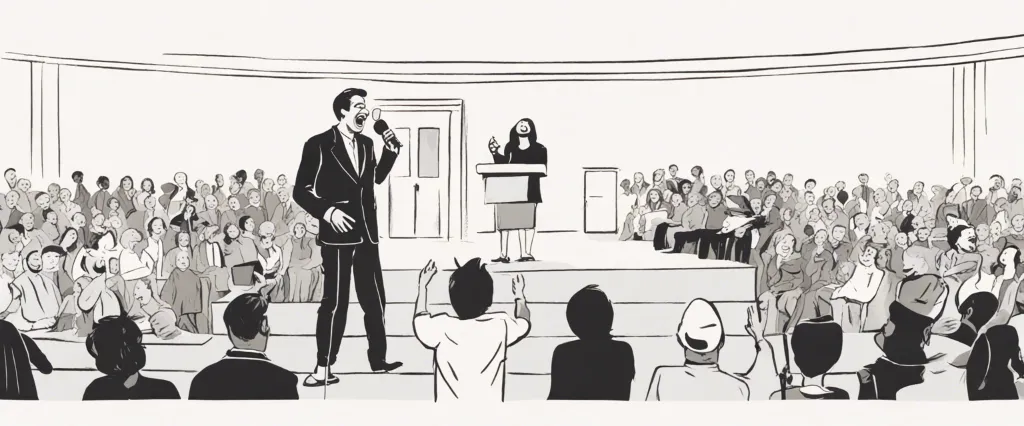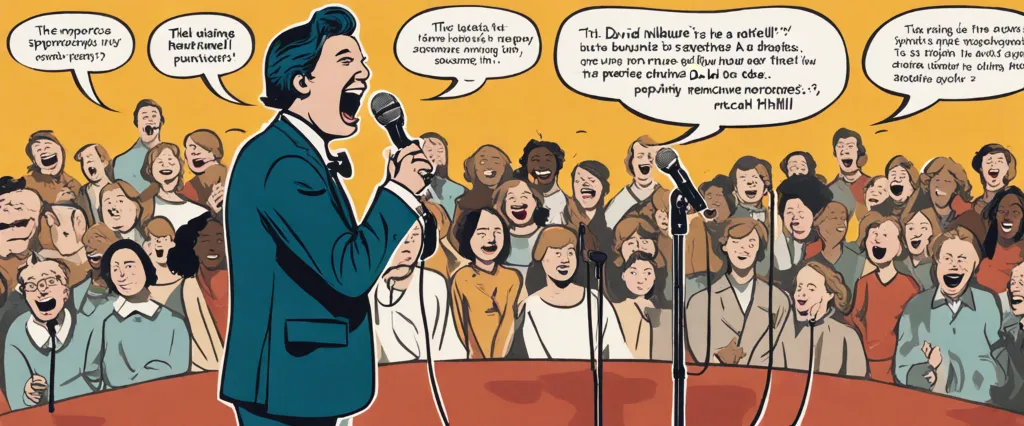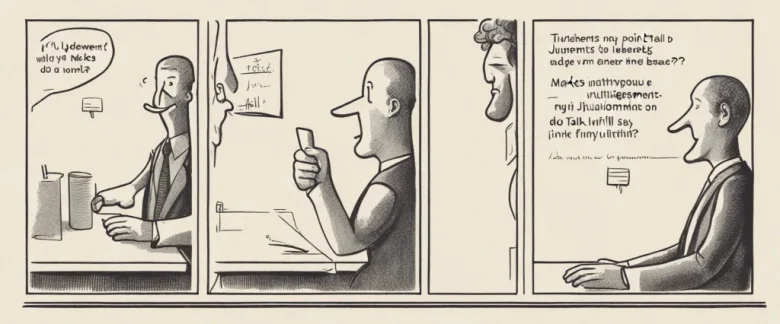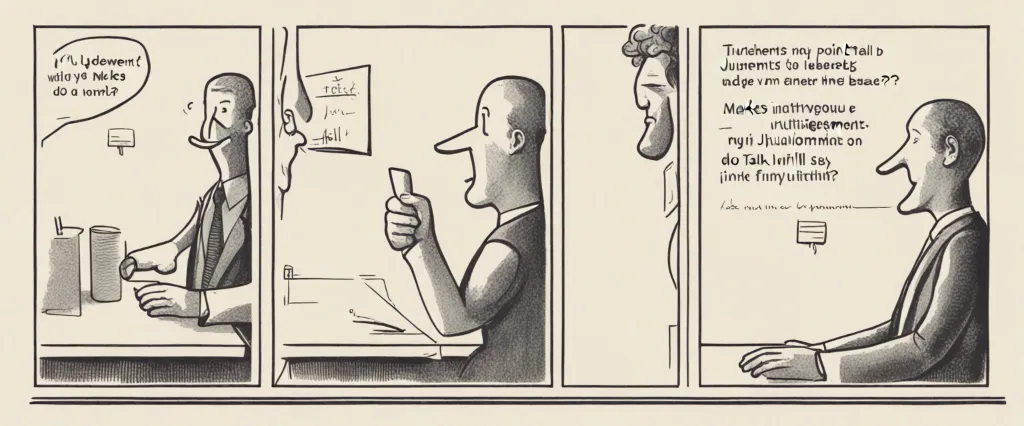In his witty and insightful book, “Do you talk funny?“, David Nihill explores the art of stand-up comedy and how it can help even the most humor-impaired individuals become more engaging and captivating speakers. With a fine balance of humorous anecdotes, practical advice, and expert insights from renowned comedians, Nihill takes readers on a journey to conquer their fear of public speaking and unlock the power of comedic communication. As an accomplished speaker, comedian, and founder of FunnyBizz Conference, David Nihill merges his passion for comedy and public speaking to equip readers with the essential tools to captivate any audience.
Chapter 1: The Fear of Public Speaking
In Chapter 1 of the book “Do You Talk Funny?” by David Nihill titled “The Fear of Public Speaking,” the author explores his personal experience and struggle with public speaking anxiety. Nihill begins by sharing a humorous anecdote about his terrifying experience of delivering a best man speech at his friend’s wedding. This incident, along with other unsuccessful attempts at public speaking, causes him to develop a deep fear and anxiety surrounding speaking in front of an audience.
Nihill highlights the widespread fear of public speaking, citing various studies that consistently rank it as one of the top fears people have, even surpassing the fear of death for some individuals. He examines the reasons behind this fear, emphasizing the fear of judgment, rejection, and the potential for embarrassment.
The chapter also explores the evolutionary reasons for this fear, suggesting that it stems from our ancestors’ need to fit into social groups and the fear of being ostracized. However, Nihill argues that in today’s world, this fear has become exaggerated and irrational, as public speaking is often a necessary skill in various professional and personal situations.
To overcome his fear, Nihill embarks on a journey to learn from successful and effective public speakers. He attends Toastmasters meetings, seeks advice from renowned speakers, and learns valuable techniques to manage anxiety and improve his public speaking skills. Through his experiences and research, he identifies key strategies such as incorporating humor, storytelling, and practicing mindfulness to overcome the fear of public speaking.
Overall, Chapter 1 of “Do You Talk Funny?” sets the foundation for the book by exploring the common fear of public speaking, its underlying causes, and the author’s personal quest to conquer his own fears and become a more confident speaker.
Chapter 2: The Power of Humor
Chapter 2 of “Do You Talk Funny?” by David Nihill, titled “The Power of Humor,” explores the various ways in which humor can be used effectively in public speaking. Nihill begins the chapter by acknowledging that humor is a powerful tool that can engage and connect with an audience, making it an essential skill for any speaker.
The author first delves into the concept of self-deprecating humor, emphasizing that the ability to laugh at oneself can help to break the ice and establish a genuine connection with the audience. Nihill provides examples of successful self-deprecating humor used by famous comedians and emphasizes the importance of striking a balance between modesty and confidence.
Next, Nihill discusses the influence of observational humor, focusing on the ability to find humor in everyday situations. He highlights the importance of being a keen observer and outlines strategies for identifying amusing aspects of mundane situations that can resonate with the audience.
The chapter also explores the role of storytelling in humor. Nihill emphasizes the power of anecdotes, explaining that personal stories can make the speaker more relatable and memorable. He provides guidance on crafting engaging narratives, including the use of vivid details and unexpected twists to capture the audience’s attention.
Furthermore, Nihill explores the concept of timing in humor, emphasizing that delivery is as important as the content itself. He explains the significance of pauses, inflection, and body language in adding comedic effect to speeches.
In summary, Chapter 2 of “Do You Talk Funny?” explores the power of humor in public speaking. Nihill describes the effectiveness of self-deprecating humor, observational humor, storytelling, and timing in engaging and connecting with the audience. By incorporating these techniques, speakers can enhance their communication skills and deliver more engaging presentations.
Chapter 3: Finding Your Funny
Chapter 3 of “Do You Talk Funny?” by David Nihill focuses on finding your own sense of humor and incorporating it into your public speaking or comedic endeavors. Nihill begins by emphasizing the importance of authenticity and encourages readers to embrace their natural sense of humor.
The chapter explores various techniques to discover what makes you funny. Nihill suggests examining your own life experiences, as unique stories often carry comedy naturally. By reflecting on personal anecdotes and adding humor to them, you can create engaging and relatable content for your audience.
Nihill also introduces the concept of the Rule of 3, where a series of three elements presented in a comedic context creates a rhythm that is inherently funny. He advises practicing the Rule of 3 by analyzing jokes and humorous situations to understand how it works.
The author further discusses the importance of timing and delivery in comedy. Nihill stresses that understanding comedic timing and experimenting with different delivery styles allows you to enhance your funny factor significantly. He suggests analyzing comedians you admire and taking note of their timing techniques to refine your own abilities.
To foster creativity and generate fresh material, Nihill recommends indulging in brainstorming activities. These can involve generating random ideas, playing a word association game, or creating mind maps. These techniques can help unlock your unique brand of humor and expand your comedic repertoire.
In summary, Chapter 3 of “Do You Talk Funny?” emphasizes the significance of finding your funny. Nihill encourages readers to embrace their authenticity, tap into their personal experiences, utilize the Rule of 3, master comedic timing, and engage in brainstorming sessions to discover and develop their sense of humor. By doing so, individuals can effectively incorporate humor into their public speaking or comedic pursuits.
Chapter 4: The Structure of Comedy

Chapter 4 of the book “Do You Talk Funny?” by David Nihill explores the structure of comedy and provides insights into how comedians structure their jokes for maximum comedic effect. Nihill dives into the importance of timing, setup, and the punchline to create humor.
The chapter begins by highlighting the significance of timing, stating that comedy is all about delivering the punchline at the right moment. Nihill emphasizes that comedians meticulously plan the timing of their jokes to build anticipation and create laughter. He also discusses how comedians use pauses and silence as powerful tools to engage the audience and create comedic tension.
Moving on, Nihill explores the concept of the setup. He explains that the setup is essential as it establishes the context and prepares the audience for the punchline. Comedians often use misdirection, wordplay, or exaggerated situations to set up their jokes effectively. Nihill provides examples of various comedic techniques used to set up jokes, such as callbacks and incongruity.
The punchline, the release of tension and the climax of the joke, is then explored in detail. Nihill explains that delivering a well-crafted punchline is crucial for eliciting laughter. Comedians often rely on surprise, irony, or unexpected twists to create punchlines that resonate with the audience.
In this chapter, Nihill emphasizes the importance of rehearsing and refining jokes through trial and error. He encourages aspiring comedians to experiment with different structures and learn from experienced comics to develop their unique comedic style.
Overall, Chapter 4 of “Do You Talk Funny?” delves into the mechanics of comedy, explaining how timing, setup, and punchlines are intricately woven together to create humor. Nihill emphasizes that understanding and incorporating these elements into one’s comedic routine can help aspiring comedians become more effective and successful in making people laugh.
Chapter 5: Crafting Your Story
Chapter 5: Crafting Your Story of the book “Do You Talk Funny?” by David Nihill dives into the process of constructing an engaging and entertaining speech or presentation. Nihill emphasizes that humor plays a vital role in making speeches memorable, relatable, and enjoyable for the audience.
The chapter begins by highlighting the importance of crafting a compelling opening, as it sets the tone for the entire speech. Nihill takes the reader through practical exercises to brainstorm and refine intriguing opening lines, focusing on humorously addressing common challenges, unexpected twists, or employing clever wordplay.
Moving on, Nihill introduces the concept of the “Rule of Threes” as a powerful tool in comedy writing. By structuring jokes or anecdotes around three elements, the speaker creates anticipation and cohesion, making the punchline more effective. Using various examples, he illustrates how to implement this rule to maximize comedic impact.
Nihill then explores the significance of storytelling within speeches, urging readers to share personal narratives or anecdotes to connect with the audience on an emotional level. He provides guidelines on selecting relatable experiences, emphasizing vivid descriptions, and creating tension or intrigue to keep the listeners engaged.
Moreover, the author emphasizes the importance of identifying the central message or theme of the speech, ensuring that all jokes and anecdotes support and enhance this main idea. He guides readers on crafting a logical and coherent structure, using transitions to smoothly move from one point to another while maintaining the audience’s interest.
Finally, Nihill stresses the significance of rehearsing and refining the speech to deliver it effectively. He advises recording practice sessions, seeking feedback from trusted individuals, and focusing on non-verbal cues, such as pacing, gestures, and vocal variety, to enhance the overall impact.
In summary, Chapter 5 of “Do You Talk Funny?” is a comprehensive guide to crafting an engaging and humorous speech. Nihill provides practical advice on creating an attention-grabbing opening, leveraging the “Rule of Threes,” incorporating storytelling techniques, structuring the speech effectively, and rehearsing for success.
Chapter 6: Delivery and Timing
Chapter 6 of “Do You Talk Funny?” by David Nihill focuses on the important aspects of delivery and timing when it comes to delivering a humorous speech or presentation. Nihill brings up the analogy of a stand-up comedian playing a room full of people to highlight the significance of these elements in engaging an audience.
The chapter starts with the author emphasizing the essence of timing, explaining that it refers to when to deliver a punchline or humorous remark in order to maximize its impact. Nihill suggests that a well-timed joke can create a stronger connection with the audience and make them more receptive to the speaker’s message. He emphasizes the importance of practicing and refining the delivery to ensure that it feels natural and effortless.
Nihill also highlights the significance of adjusting the delivery based on audience reactions. He advises speakers to pay attention to cues such as laughter, applause, or silence, which can indicate whether the intended humor is being well-received. Adapting the pace, volume, and timing based on these reactions helps maintain the audience’s engagement and interest. The author shares his personal experience of adapting his delivery during a TEDx talk, which resulted in an increased response from the audience.
Furthermore, Nihill explores the impact of body language and facial expressions on comedic delivery. He explains that using appropriate gestures and expressions can enhance the humor and make the delivery more engaging. Additionally, he suggests incorporating physical comedy techniques when appropriate, as they can further captivate the audience.
In summary, Chapter 6 focuses on the crucial role of delivery and timing in delivering comedic content effectively. By understanding the importance of timing, adjusting delivery based on audience reactions, and incorporating appropriate body language, speakers can maximize the impact of their humor and better connect with their audience.
Chapter 7: Handling Hecklers and Tough Crowds
Chapter 7 of “Do You Talk Funny?” by David Nihill focuses on strategies for handling hecklers and tough crowds during public speaking engagements. The author acknowledges that dealing with interruptions and challenging audiences can be one of the most daunting aspects of being a comedian or speaker. However, he provides useful techniques to defuse these situations and keep the audience engaged.
Nihill emphasizes the importance of being mentally prepared for heckling or difficult crowd reactions. He highlights the concept of maintaining a positive mindset and not letting the interruption derail the entire talk. Responding with humor, grace, and empathy can often defuse tension and turn a negative situation into a positive one.
The author suggests different types of hecklers and provides practical approaches to handle each. For example, he outlines strategies to address “The Accidental Heckler,” someone who unintentionally disrupts the talk. Nihill advises engaging with them briefly and then swiftly redirecting back to the main topic.
In addition to specific heckler scenarios, Nihill offers general tips for managing tough crowds. He stresses the importance of acknowledging the difficulty of the audience, subtly reminding them of their role as listeners, and actively involving them in the presentation. By doing so, speakers can regain control and regain the audience’s attention.
To effectively deal with challenging scenarios, Nihill suggests practicing responses to potential heckling situations and drawing from personal experiences or stories. He also encourages speakers to seek support from trusted colleagues or mentors who can provide valuable advice and feedback.
Overall, Chapter 7 provides practical advice and techniques for speakers to handle hecklers and difficult crowds. By adopting a positive mindset, using humor, and actively engaging the audience, speakers can navigate interruptions and maintain the flow of their presentations.

Chapter 8: The Joy of Speaking
Chapter 8 of the book “Do You Talk Funny?” by David Nihill is titled “The Joy of Speaking” and focuses on how to enjoy the experience of public speaking. In this chapter, Nihill shares his personal journey of overcoming stage fright and developing a passion for public speaking.
Nihill begins by discussing the fear that many people have when it comes to speaking in front of an audience. He acknowledges that fear is natural but emphasizes the importance of not allowing it to control or limit oneself. He suggests adopting a mindset of excitement and curiosity instead, which helps to shift the focus from fear to enjoyment.
To cultivate this joy of speaking, Nihill suggests several strategies. First, he emphasizes the importance of finding a topic that genuinely interests and excites the speaker. When the speaker is passionate about the subject matter, it naturally translates into enthusiasm and engagement with the audience.
Second, Nihill encourages speakers to embrace humor and laughter. He believes that incorporating jokes and lighthearted moments into speeches not only entertains the audience but also helps to reduce tension and create a more enjoyable experience for everyone involved.
Furthermore, Nihill advocates for practicing and refining one’s speaking skills regularly. He recommends seeking out opportunities to present in front of different audiences, such as attending open mic nights, joining Toastmasters, or participating in improv classes. By continually challenging oneself and learning from each experience, the joy of speaking can be nurtured and developed over time.
Overall, Chapter 8 of “Do You Talk Funny?” highlights the importance of finding enjoyment in public speaking and offers practical strategies for overcoming fear, embracing humor, and continuously improving one’s speaking skills. By adopting a joyful mindset and honing one’s abilities, Nihill believes that anyone can transform their fear of speaking into a positive and rewarding experience.
After Reading
In “Do You Talk Funny?” by David Nihill, the author takes readers on a humorous journey through the world of public speaking and the art of comedy. Nihill shares his own experiences as a nervous speaker and his transformation into a confident presenter. With an engaging writing style and practical tips, he emphasizes the importance of incorporating humor into speeches to captivate an audience. Through anecdotes and interviews with renowned comedians, the book offers valuable insights into the principles of comedy. Overall, “Do You Talk Funny?” is an entertaining and informative guide that encourages readers to embrace their funny side and become more confident communicators.
1. “The Art of Comedy Writing” by Arthur Asa Berger – This book delves into the techniques and principles of writing humor, offering practical advice and examples to help you develop your comedic skills. It provides a comprehensive overview of comedy writing, exploring humor styles, joke structure, and comedic timing.
2. “Born Standing Up: A Comic’s Life” by Steve Martin – In this memoir, Steve Martin shares his fascinating journey from a young aspiring magician to one of the most successful stand-up comedians of his time. With wit and insight, Martin reflects on his experiences in the world of comedy, offering valuable insights into the creative process and what it takes to make people laugh.
3. “The Comic Toolbox: How to Be Funny Even if You’re Not” by John Vorhaus – This book provides aspiring comedians with a practical toolkit to develop their comedic voices. Vorhaus explores various comedy techniques, such as wordplay, misdirection, and parody, guiding readers through exercises and examples to help enhance their comedic skills.
4. “Comedy Writing Secrets: The Best-Selling Guide to Writing Funny and Getting Paid for It” by Mark Shatz and Mel Helitzer – This book is a comprehensive guide to comedic writing that covers everything from humor theories to creating comic characters. With practical exercises and real-world examples, the authors offer valuable insights into the different aspects of comedy writing, helping readers hone their skills and pursue a career in humor.
5. “Sick in the Head: Conversations About Life and Comedy” by Judd Apatow – In this collection of interviews, Judd Apatow, a prominent figure in comedy, interviews some of the funniest and most influential comedians of our time. These candid conversations provide unique insights into their humor, careers, and creative processes, offering a wealth of inspiration and wisdom for anyone interested in the world of comedy.




